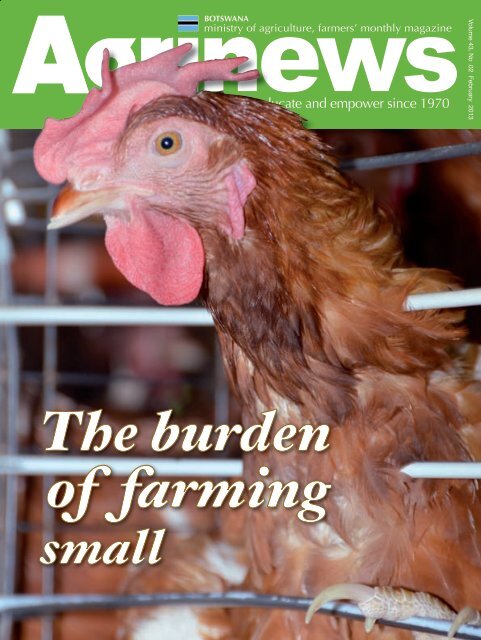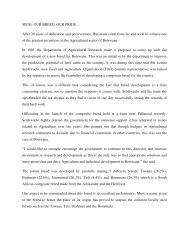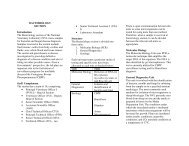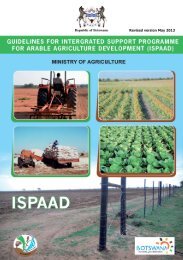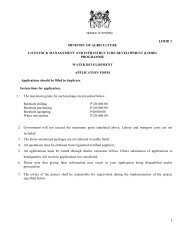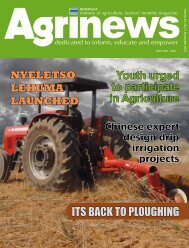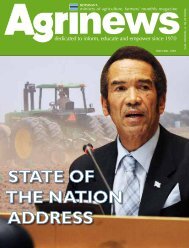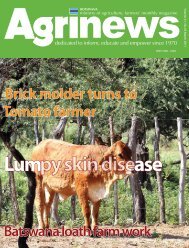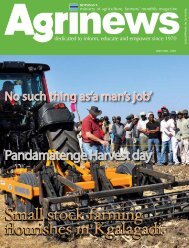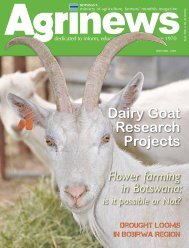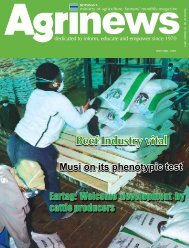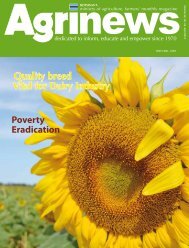Agrinews February 2013 - Ministry of Agriculture
Agrinews February 2013 - Ministry of Agriculture
Agrinews February 2013 - Ministry of Agriculture
- No tags were found...
Create successful ePaper yourself
Turn your PDF publications into a flip-book with our unique Google optimized e-Paper software.
Volume 43, No .02 <strong>February</strong> <strong>2013</strong>The burden<strong>of</strong> farmingsmall
<strong>February</strong> <strong>2013</strong>1
A G R I N E W S F E B R U A R Y<strong>2013</strong>ContentsEditorialBee Business inheritance2 212The burden <strong>of</strong> farming small2 42 62 8210Horticulture as a business <strong>of</strong> choiceThe Ruthlesssness Calender (Revised 2011)6Turning waste into treasureThe ruthlessness <strong>of</strong> tilling soil with fuel211Legume fodder crops213Teasers216YouthWord grid21721810<strong>Agrinews</strong> BW11Moreri MoesiEditor: Reporters:Joseph Ramodisa France BegenselKeamogetse BoitshepoKeseg<strong>of</strong>etse TaweleOnalenna KelebemangGorata MuzolaMokgarebe MotswakhumoEsther NkgwangModiegi MadumetsaKeabetswe MolebatsiDesigner:Eshley NageCecilia BashanakoHead Of PhotographyHenry TotoPhotographers:Pius NkundaIbo Charity Makhumalo<strong>February</strong> <strong>2013</strong>
editor’s noteFOUNDATIONPILLARSERADICATING POVERTY THROUGH AGRICULTUREVISIONAttain national food securityand global competitivenessin agricultural productsMISSIONTo improve agricultural productivitythrough technology developmentand transfer, diversification andcommercialization, inorder to promote food security inpartnership with our stakeholders.VALUES1. BOTHOWe treat our customers ina respectable and caring manner.2. TEAM WORKWe recognize the need to work asa team characterized by collectiveeffort, trust, understanding,support and perseveranceirrespective <strong>of</strong> rank or gender.3. CUSTOMER FOCUSEDOur customers are the focus<strong>of</strong> everything we do by beingcourteous, caring, compassionate,tolerant and empathetic.4. INNOVATIVEWe commit to employ new ideasand being proactive in order tomatch the requirements <strong>of</strong> thefuture.5. INTEGRITYWe foster a culture <strong>of</strong> transparency,accountability and dependability.Imagine the world where rainfallstops, crops start failing andpeople start dying <strong>of</strong> hunger.This will amount to the biblicalSodom and Gomorrah, particularlyfor subsistence farmers who arealways hard hit by poverty. Farmingis as old as humanity. About 70%<strong>of</strong> the poor in developing countries(Botswana inclusive) is directly tiedto agriculture for food security. It isclear agriculture is a single largestsource <strong>of</strong> employment.We believe that agriculture playsan important role to eradicatepoverty especially at micro level.Hence government assistanceprogrammes in various agriculturesub-sectors such as backyardgardening, beekeeping and smallstock. Since 2010 over 1000people were assisted with backyardgardens, 300 with small stock and69 benefited from beekeeping.These projects are not just materialresources <strong>of</strong> poverty eradication;it is an effort by the governmentto ensure that food security athousehold level is attained andthe Millennium Developmentgoal achieved. Through selection<strong>of</strong> sub sectors <strong>of</strong> goat meat(chevon), vegetable and honeyproduction, the government is notonly addressing the issue <strong>of</strong> foodsecurity, but also food nutrition.We all know that goat meat andhoney are scarce commodities inthis country (demand for honey40t: local supply 13t), hence anopportunity for the beneficiariesto take advantage <strong>of</strong> the niche inthe market to empower themselvesfinancially.It is now up to beneficiariesto excel in these programmesso that poverty is eradicated.Poverty eradication is notthe sole responsibility <strong>of</strong> thegovernment. The government canonly supplement efforts <strong>of</strong> thehouseholds.Like us on facebook: <strong>Agrinews</strong> BWWebsite: www.moa.gov.bwPortal: www.gov.bw1<strong>February</strong> <strong>2013</strong>
<strong>February</strong> <strong>2013</strong> 2
Article & photos:Keamogetse BoitshepoAt the age <strong>of</strong> 28, ThatoNgome had to suddenlyfill in the big shoes <strong>of</strong>her mother, mentor and rolemodel. Her mother was a woman<strong>of</strong> tenacity who endured manydifficult seasons with grace andthat catapulted her into beingone <strong>of</strong> exemplary bee keepers inKweneng West.Ngome describes her mother’sjourney as one that started<strong>of</strong>f humbly as a veld productsvolunteer. Through volunteering,she got an opportunity to betrained on bee keeping. That wasthe beginning <strong>of</strong> many years <strong>of</strong>countless triumphs and challenges.On her passing the course in June2012, she had established anapiary with 10 beehives. Being theeldest, Ngome knew by defaultthat she has to mature quicklyand continue the project that hadsustained her family for decades.“Honey has always been the onlysource <strong>of</strong> income that my motherhad to raise me and my youngersisters up.”To the Ngome family, honeybusiness has <strong>of</strong>ten proved tobe a reliable source <strong>of</strong> income.According to Ngome, one <strong>of</strong> themost dreadful days were end <strong>of</strong>school holidays for her secondaryschool years. Hailing from a smallvillage <strong>of</strong> Motokwe, Ngome hadto attend boarding school whichrequired her to have transport andpocket money. She reveals that<strong>of</strong>ten she would not have enoughmoney to go back to school.“At such times, I had to put on abrave heart and harvest as muchhoney as I could. It <strong>of</strong>ten happenedthat I would be by myself with noone to lend a hand.”All by herself, Ngome revealsthat she would go around thevillage selling honey. By the end <strong>of</strong>the day, she most times had raisedthe amount needed for school.Wondering how a teenagerwould be able to harvest honeyfrom ferocious bees that areknown to bite to kill, Ngome saysthat bees have been part <strong>of</strong> her lifeas long as she remembers.“Bees are like flies to me. Ourmother involved us in the businessfrom an early age. We all knowthe ins and outs <strong>of</strong> a bee keepingbusiness.”Juggling her entrepreneurshiptertiary studies at LimkokwingUniversity <strong>of</strong> Creative Technologyand running a bee keepingbusiness is obviously demanding.Ngome is grateful to havesupportive siblings who are alsotaking part in business. However,she had to hire someone to carefor the apiary since she staysin Gaborone and only goes toMotokwe on some weekends.Considering the dry spell thecountry is currently experiencing,she explains that hiring anassistant manager was a necessity.“When is dry like it is now withno flowers in the apiary and thesurroundings areas. We have tomake bees syrup. It’s a simplemixture <strong>of</strong> sugar and water.”According to Ngome, beekeeping does not have highoperational cost as most timesthe bees harvest from natural veld.In cases <strong>of</strong> drought, Ngome saysthe cost go higher by a negligibleamount. She estimates that onebox or a beehive produces honeyworth approximately P600.00while a 40g bottle <strong>of</strong> honey sellsfor P60.00.As the bee keeping sub sectoris growing to include producingbee wax byproducts, Ngomeis planning to ride this tide <strong>of</strong>development and make use <strong>of</strong>what its waste at the moment. Awide range <strong>of</strong> byproducts that sheis learning to make is lip balm,candles, body lotion and bath oils.Ngome also celebrates thedevelopments in the sub sectorwhich have made bee keepingeasy for many people. She smilesrecalling their ways <strong>of</strong> catchingbees before introduction <strong>of</strong>protective clothing.“Then we used to burn donkeydung to drug bees with the smokebefore we could catch them. Wewould place it close to the hive.While they are toxicated andless volatile, we caught them orharvested honey.”The District Regional BeeKeeping Officer for Kweneng,Keolege Malema says bee keepinghas improved economic status<strong>of</strong> many families in the region.Bee Keeping Officers teach thekeepers pr<strong>of</strong>itable pricing andeffective management <strong>of</strong> beekeeping. He says the general care<strong>of</strong> bee keeping, include curbingpests from the hive. Such pestsinclude ants, bee parates and beebeetle.“One preventative method is toput a piece <strong>of</strong> mirror in a basinwith a mixture <strong>of</strong> water andparaffin. Then place it in front <strong>of</strong>the hive entrance. The pirates willdrown in the water and die whenthey attempt to enter the hive.”Malema says beetles alwaysfind their ways into the hive sothis makes regular inspections <strong>of</strong>the hive unavoidable. Further,hesays providing bees with syrupduring drought is <strong>of</strong> fundamentalimportance to keep the businessgoing. The solution, he says ismade <strong>of</strong> 1:1 ration, meaning whatever measurement <strong>of</strong> water you putfor the solution, the sugar shouldbe <strong>of</strong> the same measurement.Malema says changes in theclimatic conditions calls forfarmers to carry out projects thatdo well in their regions.3<strong>February</strong> <strong>2013</strong>
The burdenArticle & Photos: Joseph RamodisaOne <strong>of</strong> the biggestchallenges to smallfarms comes from bigfarms. Due to economies <strong>of</strong> scale,a 5,000 bird’s capacity poultryfarm is able to charge less perdozen <strong>of</strong> eggs for the thousands<strong>of</strong> eggs it produces every year,than the small farm can for itshundreds <strong>of</strong> the same product.Despite the high cost <strong>of</strong> layers,many health, phyto-sanitary andinfrastructure regulations requireinvestments that only largefarms can afford, thereby addinganother financial challenge tothe small farmer. An example<strong>of</strong> this was the requirement <strong>of</strong>a certain size <strong>of</strong> bulk tanks indairies, a regulation that putmany small dairy farms out <strong>of</strong>business because they could notafford the equipment.Ofentse Gabalathane <strong>of</strong>Mopipi Village in Boteti, an eggproducer funded through CEDA’sYoung Famers Fund is an example<strong>of</strong> those feeling the pinch <strong>of</strong>competing with big farmers forthe market. The situation thatforced him to go out <strong>of</strong> business<strong>of</strong> egg production.The fact that Gabalathane stillhas a loan to service with CEDA,he has now opted to go for broilerproduction so he can be able topay the loan.Though he describe layers aseasy to manage and maintainas compared to broilers,Gabalathane pointed out thathe is running away from stiffcompetition that small farmersare facing from big ones.He said small farmers as wellas big ones are taking their dayto day requisites from the sameservice providers, at the sameprice, but when it comes toan economic <strong>of</strong> scale they areoutclassed by big farms.He cited feeds which he saidthey only purchased in Palapyewith extra costs for transport totransport them to their farmsand consequently the cost <strong>of</strong>production becomes high. As aresult, he said they are forced toprice their end product higherthan the big<strong>February</strong> <strong>2013</strong>
<strong>of</strong> farmingfarms, taking into considerationthe cost incurred during theprocess.This directly affect themnegatively since buyers willconsider the price <strong>of</strong> a commoditywhich in most cases the bigfarms always win even thoughthe quality is the same.“It is this market that wedepend on for capital in orderto pay back the loans we havewith CEDA, but the market issmall ”there, what burdens us is that weare farming small with high inputcost therefore we have to put ourprices a bit high.” As a result <strong>of</strong>this, the market chooses thosefrom big farmers since their priceis less.Mr Samuel Tjetjoo, Head <strong>of</strong>poultry section, <strong>Ministry</strong> <strong>of</strong><strong>Agriculture</strong> said they are aware<strong>of</strong> such problems <strong>of</strong> which heassociated with lack <strong>of</strong> propermarket research by the producer.“It is through the proper marketresearch that can provideinformation about the productionlevel.”Though Gabalathane articulatethat for one to be pr<strong>of</strong>itable inegg production, he needs to havea flock <strong>of</strong> at least 4 000 birds inproduction, Tjetjoo believes it isnot about the number but ratherthe proper market research thatdetermines the pr<strong>of</strong>itability <strong>of</strong> thebusiness.He used the phrase ‘start smalland grow bigger’ as a guidance tosmall egg producers, particularlyin Boteti area to target thosesmall markets they can be able tosustain such as hotels and smallgeneral dealers.Kelapisitswe Lebonetse <strong>of</strong>Ndaba Poultry in Letlhakane andalso a CEDA Young Farmers Fundbeneficiary highlighted that thecompetition for market with bigfarms is a threat to their existence.Unlike Gabalathane, Lebonetseis not willing to quit eggproduction and prefer to riseup and soldier on even if thereare some challenges. They buythe feeds from Francistown ataddition costs for transport. Hecited these additional costs asa reason why they are forced toprice their products higher thanthe big farmers.Lebonetse said the eggproduction business needs alarge number <strong>of</strong> birds for starterups to be pr<strong>of</strong>itable, but at aprice <strong>of</strong> P76 a bird, they as smallfarmers cannot afford.To address the problem suchas purchasing feeds far fromtheir projects, Tjetjoo urge themto always consult with PoultryFarmers Association in theirrespective area to influencepoultry feeds suppliers to openan outlet in their vicinity.In an event <strong>of</strong> buying feedsfar from their area, he advicethem to group themselves sothey can buy in bulk and cut thetransportation costs. And in thisarrangement, he said Feed Centeris will to help those who can doso.5<strong>February</strong> <strong>2013</strong>
Horticulture“I feel is time for me to explore anagricultural side <strong>of</strong> my pr<strong>of</strong>essionon a commercial basis. It is anotherextension <strong>of</strong> my passion.”Article: Keamogetse BoitshepoPhotos: Pius NkundaA horticulturist bypr<strong>of</strong>ession, who dedicatedthe past 12 years <strong>of</strong> his lifeto a landscaping business,is sinking his teeth in theagricultural sector. In aspace <strong>of</strong> three years, theinnovative business man, MrQuett Rabai has secured threedifferent fields to pursue hisintegrated farming passion.“I feel is time for me to explore anagricultural side <strong>of</strong> my pr<strong>of</strong>essionon a commercial basis. It is<strong>February</strong> <strong>2013</strong> 6
as a Business <strong>of</strong> Choiceanother extension <strong>of</strong> my passion.”Walking in his 12 hectareOrange Grave farm in Kgope,there are heaps <strong>of</strong> butternut,tomatoes, green pepper bags andwatermelons. The employees arefinishing preparing orders thatwill be picked up in no time.Rabai explains that the vegetablesare divided into different qualitygrades looking at their size andthe appearance among otherthings. His clients which aremainly chain supermarketsincluding Vegeland, Choppies,Pick’nPay and Mr Veg buy fordifferent clientele.However, Rabai notes that themarket for vegetables in Botswanais not stable, hence he has tonegotiate prices in every saledeal. The fluctuation <strong>of</strong> pricesaccording to Rabai, is dependanton the saturation <strong>of</strong> vegetables inthe market.“Influx <strong>of</strong> imported vegetablesfrom South Africa saturates themarket and causes a decreasein prices for locally producedvegetables. This is sad andfrustrates efforts <strong>of</strong> local farmers.”Like the adage “the earliest birdcatches the fattest worm,” Rabaiensures he is amongst the first toharvest in order to get good pricesfor his produce.Resembling other industries,the horticulture sub sector issurvival <strong>of</strong> the fittest. As such,Rabai could not over emphasizethe importance <strong>of</strong> thoroughunderstanding <strong>of</strong> trends andtimely production in order tobe pr<strong>of</strong>itable. Considering theclimatic conditions, Rabai saysspecial consideration also goes toplanting proper vegetables for theseason.“We mainly plant leafy crops inwinter because they are resistantto frost. Fruity vegetables areplanted in summer for their heatand storm tolerance traits.”Rabai plants different vegetablesat the same time; currently hehas tomatoes, green pepper,butternuts and melons. To spreadthe risk since he has not yet builtnets he plants them at differentintervals.“We organize planting in sucha way that when we sell a batchanother is maturing. This alsocreates continuity in our supplyover a period <strong>of</strong> time.”The method, according toRabai keeps continuity in thebusiness, such that the businessis constantly active.While his enterprise is doingwell at the moment, Rabaireminisces <strong>of</strong> the hard lessonshe had to learn to be where he is.His early days in the horticulturebusiness were met by the hardrealities <strong>of</strong> not doing a marketresearch. Excited to finallypursue his passion, Rabai sayshe planted vegetables like springonion that would be preferred bya smaller fraction <strong>of</strong> the market.His aim was to sell to certainchain supermarkets. When theproduce was ripe, he did notmanage to secure a business dealhence ended up with heaps <strong>of</strong>rotten produce.As a result, Rabai resorted toplanting common vegetables thatcan be easily bought even onthe streets like chomolia, rape,tomatoes, melons and butternut.“I plant horticulture producethat majority <strong>of</strong> the populationprefer as such I sell to chainsupermarkets and vendors. Thevegetables are on demand; <strong>of</strong>tenscarcity <strong>of</strong> the market is not anissue but meeting the requiredquantities.”Having self sponsored theestablishment <strong>of</strong> the enterpriseRabai fights tooth and nailto ensure that the project issuccessful. He emphasized theimportance <strong>of</strong> controls, checksand balances <strong>of</strong> operations inorder to make pr<strong>of</strong>it. He says fromjust ¼ <strong>of</strong> a hectare, he harvestabout 500 bags <strong>of</strong> butternuts.With a good price he says hemakes his pr<strong>of</strong>it.“When starting up I had t<strong>of</strong>inance purchasing <strong>of</strong> the field,drilling boreholes and installingdripping system. These are verycostly but I am confident that Iwill get return on investment in agood time.”To fully utilize the 12 hectares atOrange Grave, Rabai divided thefield into three sections to caterfor his other agriculture interests.“Two and half hectares are usedfor horticulture and the othertwo parts are divided betweendry land farming and animalhusbandry.”The animal husbandry side<strong>of</strong> the farm is divided to housesducks, tswana chickens, rabbitsand goats. Rabai prefers integratedfarming for its reciprocal traiton each sub sector. He feelshis smallstock and poultry withhorticultural produce and use theanimal waste like chicken litteron the fields as maure.7<strong>February</strong> <strong>2013</strong>
APICULTURE SEASONALCALENDAR (REVISED 2011)January <strong>February</strong> March April May June July August September October November Decemb.......Honey Flow......HarvestPeriod............Dearth PeriodTraining <strong>of</strong> farmer’s and Extension staff......Build Up PeriodDEARTH PERIODActivities:* Secure market* Feed weak colonies* Unite weak colonies to improve colony strength.* Provide warmth/shelter to all colonies* Provide water* Remove all old combs and render beeswax* Reduce the number <strong>of</strong> entrance holes* Control pests* Clean / repair equipment and store safely* Maintain/construct fire breaks for protectionagainst fi re.* Record all activitiesBUILD UP PERIODActivities:* Continue feeding weak colonies* Control pests* Unite weak colonies / swarms* Re-queen colonies* Bait/site trap hives* Divide strong colonies to stock empty hives* Plant melliferous plants* Prepare processing equipment and packagingmaterials* Record all activitiesHONEY FLOWActivities:* Control <strong>of</strong> pests and predators* Ensure that all colonies have got enoughspace ( working space )* Break swarm cells to delay swarming* Delay swarming through early harvestor supering* Harvest ripe honey* Record all activitiesHARVEST PERIODActivities:* Harvest all sealed honey combs* Process honey and package* Record all harvests* Render bees wax* Continue control <strong>of</strong> pests* Allow bees to clean all harvested supers<strong>February</strong> <strong>2013</strong>8P O Box 00435 Gaborone Tel: 689361/62Chief Horticulture & Beekeping Officer
SUB-DISTRICTMONTHer.......J F M A M J J A S O N DCENTRALMahalapye hf hf h h h h d d b b b bMachaneng hf hf h h h h d d d b b bPalapye hf hf h h h h d d b b b hfSerowe hf hf h h h h d d d b b bLetlhakane b hf hf h h d d d d d b bSelibe Phikwe b hf hf h h h d d d d b bBobonong b hf hf h h h d d d d b bTonota hf hf hf h h d d d d d b hfTutume hf hf hf h h d d d d d b hfNORTH EASTMasunga hf hf hf h h d d d d d b hfCHOBEKasane b b hf hf h h h d d d d bNGAMILANDNgami East hf h h h d d d b b b hf hfNgami West hf h h h d d d d b b hf hfOkavango hf h h h d d d b b b hf hfGHANZIGhanzi d d d b b b hf hf hf h h hKGALAGADIKgalagadi South hf h h d d d d b b b hf hfKgalagadi North h h h d d d d b b b hf hfSOUTHERNNgwaketse West hf hf h h h h d d d b b bNgwaketse Central hf hf h h h d d d b b b hfNgwaketse North hf hf h h d d d d d b b bBarolong hf hf h h d d d d d b b bKGATLENGKgatleng hf hf hf h h h d d d b b bSouth EastRamotswa hf hf hf h h h d d d b b bKwenengKweneng South hf hf hf h d d d d b b hf hfKweneng West b hf hf h h d d d d d b bKweneng North b hf hf h h d d d d d b bKey:b - Build periodh - Harvesthf - Honey flowd - Dearth period9 <strong>February</strong> <strong>2013</strong>
TURNING WASTEINTO TREASUREArticle: Onalenna KelebemangPhotos: Ibo MakhumaloWaste management hasalways been a problem to mostenterprises, agriculture included.Most farmers usually do notknow how to dispose wasteespecially piggery because itaccumulates in one area. Thewaste impact the environmentnegatively because it smells, itflows in small stream in thefarm and ultimately reaches thewater table beneath the earthsurface. Unfortunately, there arelaws that stipulates how wasteshould be dealt with or elseone could end up in hot smokewith the legislators. That is whyan agricultural specialist ran acourse to educate farmers onhow to manage waste.Participants were thrilled tolearn that what is termed “waste”can be <strong>of</strong> great use to them inthe long run. They began to havea different perception on howthey can use waste material. Theexpert, Mr Buti Mogotsi provedthat waste material can be usedto produce gas. He said that theformation involves the biologicalbreak down <strong>of</strong> organic matterin the absence <strong>of</strong> oxygen thusproducing “BIO GAS”. On afield trip to Lobatse, Cumberland Hotel, the farmers sawthe reality <strong>of</strong> how this gas isproduced from waste materialsand the need <strong>of</strong> networking asfarmers. The pr<strong>of</strong>essional <strong>of</strong> theBio gas plant explained howthe tank operated , he said thatfood was specifically acting asthe catalyst <strong>of</strong> that particulartank, however a farmer canresort to using different waste ascatalyst. Mr Matthews Nyatshangencouraged farmers to have theirown small tank at their farms asit really helps to cut down costs.According to Dr EzekielM.Chimbombi the coursefacilitator and project coordinator,the project was sponsored byGlobal Environment Facility(GEF) through a Small GrantsProject (SGP) on EnergyRecovery and Utilization frompiggery waste using Bio GasTechnology. He said that the aim<strong>of</strong> the course was to ensure thatpiggery farm owners or workershave the capability to quantifyand characterize the waste; theyshall generate in their productionsystems and therefore ensure thatthere is waste management plan.He was enthusiastic to encouragefarmers to be dedicated to thiscourse as there is so much tograsp.Furthermore, Dr Moagi Letsosaid that the focus <strong>of</strong> the coursewas on piggery waste materialdue to the fact that somelivestock waste is difficult tocollect a in free range. He saidthat pigs stay in a confirmed areaas a result their waste collectsand eventually they do not knowhow to manage it. The eventbecame more interesting when arepresentative from Department<strong>of</strong> Waste Management andPollution Control, Ms UnaswiMatebu took them through thewaste management Act, whichregulates on how waste can bedisposed and the consequences<strong>of</strong> not abiding by the law. Shesaid that farmers need to knowthat they are trying to helpthem as well as to promote aclean and safe environment. Itwas fascinating past because itinspired farmers find a better way<strong>of</strong> dealing away with waste.<strong>February</strong> <strong>2013</strong> 10
Theruthlessness<strong>of</strong>tilling the soil with fuelArticle & Photos: Joseph RamodisaAgribusiness is completelydependent on fuel. With theexception <strong>of</strong> miniature farmsthat can be operated by hand orwith the help <strong>of</strong> donkeys, this isas true for small farms as it is forlarge ones, because virtually allcommercial farms use tractorsand fuel-derived fertilizers andpesticides.Therefore, in addition to beingbeholden to the weather, farmersanswer to the consequences <strong>of</strong>the global fuel price.If petroleum prices spiral out <strong>of</strong>control, small farmers will befacing very serious challenges tomaintain food production and tosupport themselves.As a result it hampers effortsby the Government to improvefood security through the use <strong>of</strong>ISPAAD program because tractorowners feel that P400/ha paid tothem is not enough to cater forthe ever increasing fuel prices.“Now we are compelled to chargean upfront P200/ha <strong>of</strong> which thefarmers have to pay before thetractor tills the land, one tractorowner Evan Ntlhanogelang fromXhumo village in Boteti confirms.Evan, who described the businessas unpr<strong>of</strong>itable said, what makesit worse is the fact that they hirethe tractor operators who at theend <strong>of</strong> the day need to be paid. Asa result they as tractor owners areleft with nothing as fuel will takeall the money.The unpr<strong>of</strong>itability <strong>of</strong> the business,Evan also attributed it to smallfarms they plough in the areawhich are also far apart and notdestumped. She said operating inthose fields consume a lot <strong>of</strong> timeand fuel which is expensive totractor owners.Evan said as result <strong>of</strong> this, farmershave to pay for the fuel for theirfields to be tilled. She remindedfarmers to destump their fieldsto easy the tractor operation forthem to cover more hectares ina short period <strong>of</strong> time so they atleast make little pr<strong>of</strong>it.This is a serious challenge to smallfarmers who cannot afford thatP200/ha and it has the possibilityto reduce the total number <strong>of</strong>hectares planted as compared tolast season as some farmers areopting to plant less hectares inorder to be able to sow seeds inthe fields.A dry land farmer from Xhumovillage Balothaganye Lekgokowho has been affect by the AfricanArmy Worm, said she wantedto plant again but with lack <strong>of</strong>money to pay tractors owners shecannot make it.Though the government promisesthose who have been affectedby the outbreak <strong>of</strong> African ArmyWorm with free seeds, Lekgokosaid she can only manage ahectare out <strong>of</strong> about six hectaresthat she has the potential toplough. She cannot afford theP200/ha that is needed from themby tractor owners.Besides affecting the number <strong>of</strong>hectares to be planted this issuecan also seriously affect the cropyields during harvesting timesince tractor owners do not wantto row plant, an agronomicalpractice highly recommended<strong>February</strong> <strong>2013</strong>
for traditional dry land farmers toimprove crop yield.Kelethametse Khubuetsile als<strong>of</strong>rom Xhumo is uncomfortablewith a price <strong>of</strong> P150/ha for rowplanting which is recommendedby ISPAAD. “As a tractor owner Ican not repeat the same field withP150/ha for row planting.”Khubuetsile who acknowledgedthat he charges farmers P150/ha more than the ISPAADrecommended price <strong>of</strong> P400/hafor ploughing said instead <strong>of</strong> rowplanting, he will rather plough forthose who broadcast and move tothe next field for P550/ha.The reason for doing that isbecause <strong>of</strong> high fuel prices whichis at P10/L for diesel and runningthree different implements on thesame field is not cost effective totractor owners.Khubutsile who is not registeredwith ISPAAD said he has a planterbut never used it because it is notpr<strong>of</strong>itable looking at fuel usageand hence request for the review<strong>of</strong> these prices and be attached tocurrent state <strong>of</strong> fuel prices.Deputy Chairperson <strong>of</strong> FarmersCommittee in Mmatshumovillage Keletshabile Boatametsehas observed that, besides poorrainfall which has been primarilyassociated with poor harvest inthe past years, this year’s rainfallforecast has something in storefor them, the P200/ha paid byfarmers for fuel will negativelyaffect the harvest.She said what makes it worse isthe condition <strong>of</strong> donkeys whichthey mostly use to till the smallfarms they have and Boatametseexplain that, their draft powersare recovering slowly from lastyear’s drought as receive goodrain in mid January.She said draft powers, in mostcases recue small farmers in eventsuch as this but they cannot utilizethem in their poor condition. Asa result they will feel the pain<strong>of</strong> high fuel price as they nowdepend on it for them to catchup with the soil moisture andconsequently they have to facethe ruthless <strong>of</strong> tilling the soil withfuel. The ISPAAD Coordinator,<strong>Ministry</strong> <strong>of</strong> <strong>Agriculture</strong>, MrLepodise Telekelo said when thisprogramme was initiated 2008the fuels prices were as high asthe current situation, therefore,the problem with tractor ownersmaybe with the spare parts whichhe acknowledge are expensive.Telekelo is positive that withcareful planning with these pricestractor owners can still makepr<strong>of</strong>it, hence advised them toalways prepare on time prior tothe growing season. He gave anexample <strong>of</strong> obtaining seasonalloans from local financialinstitutions which they can useto buy fuel in advance to avoidcharging farmers during thegrowing season.When commenting on the issuewhere tractor owners preferto plough at a price <strong>of</strong> P400rather than P150 <strong>of</strong> raw planting,Telekelo said this may not bebecause <strong>of</strong> the price money butrather the window <strong>of</strong> operation.He described the window <strong>of</strong>operation in this country asnarrow, therefore pressing onfarmers to use the little rainfallreceived in a short space <strong>of</strong> time.In this circumstances where thereis shortage <strong>of</strong> tractors, Telekelosaid farmers may be forced tobroadcast in order to avoidmissing out during the period <strong>of</strong>good <strong>of</strong> rains.The coordinator also reassuredfarmers that ISPAAD programmeis under review and if thereare some changes, they will beimplemented in the next growingseason.<strong>February</strong> <strong>2013</strong> 12
...continued from January issueLegumes are a large family<strong>of</strong> trees and herbaceous plantswith seeds that grow in pods andmost <strong>of</strong> these plants have highcrude protein which is greaterthan <strong>of</strong> livestock (7%) whichfor maintenance They containhigh amount <strong>of</strong> phosphorus (P),calcium(Ca) and potassium(K)important amino acids that otherplants can not supply. They arereadily available in the country.The farmers’ produces quite anumber <strong>of</strong> them and those thatare found in rangeland is up t<strong>of</strong>armer’s choice to collect pods touse as supplements, but the choiceshould be those that are less intenan which if the amount is higherbypass protein. It would be betterto process by drying to reduce it.The below Legumes had goneunder test by Animal Productionand Range Research, <strong>Ministry</strong> <strong>of</strong><strong>Agriculture</strong> the nutrient contents<strong>of</strong> these legumes was as indicatedbelow.Table 1Selected Legumes and grassescan be mixed to improve gazingquality by complementing eachother, the grass enjoys noncompetition <strong>of</strong> nutrients and waterand hold soils with fibrous rootsby so doing improve structure andreduce soil erosion. Subsequently,legumes with longer tap rootsLEGUMES FODDER CROPSutilizes the deeper nutrients andwater with less competition andprovide nitrogen to the grasshence this combination increasesbiomass and quality feed.The quality <strong>of</strong> pasture can befurther improved and assured byinclusion <strong>of</strong> forage legumes whichretain higher quality throughout theyear. Stylosathses guianenensis andCentrosema pubescence (Legumes)have been both recommendedfor use in mixture with grasses(Ademosum1973; Mislevy 1955)Legumes Ca CP P KLablab 1.06 16.60 0.18 1.93Cowpeas 1.39 16.10 0.18 1.34Groundnuts 0.90 10.28 0.12 1.52Lucerne 1.32 16.30 0.24 2.50Jugobeans 2.10 10.40 0.06 1.50Source (Director <strong>of</strong> Agric. Research Gaborone)FODDER PRODUCTIONand have shown to improveanimal performance (Adegbolaand Onayinka 1968).It is a good feed to smallstockand had shown good results whenfed at mating, early pregnancy, midpregnancy, lactating, and weaningperiods. Flushing <strong>of</strong> goats byfeeding lablab responds by havingmultiple ovulations and giveparturition <strong>of</strong> twins and triplets.The Department <strong>of</strong> AnimalProduction (Fodder section)inconjunction with Department<strong>of</strong> Agric. Research are investigatingm o r e f o d d e r s p e c i e s a n dsimultaneously recommendingsome varieties to go underproduction. The listed below arerecommended for production andcan be produced in the country inaddition to others:>Leucaena species for browse orcut and carry>Atriplex species for browse orcut and carry>Siratro species good forimproving standing hay.>Stylo species good for oversowing to mix standing hayIn addition to the above, someconcentrates can be made athome provided instructions arefollowed carefully or with thehelp <strong>of</strong> an <strong>of</strong>ficer to assist wherepossibly. Urea-molasses blockis the simple way <strong>of</strong> providingprotein and mineral when dietaryprotein is low in pasture. Theblock accelerates fiber digestionin the rumen while molassesgive sulphur to activate rumen t<strong>of</strong>unction efficiently and grain branis added to provide energy throughcarbohydrates.13<strong>February</strong> <strong>2013</strong>
METHOD OF MAKING BLOCK (home made)Suggested drought ration incorporating sorghum stoverTable 2INGREDIENTS FOR 10KG BLOCKIngredientsQuantity (kg)Milled peanuts/ ground nuts hay 0.5Wheat/Sorghum bran 2.3Liquid Molasses 4.0Feed grade Urea 0.9Salt 0.5Dicalcium Phosphate 0.5Clay for binding 1.0Equipment neededHalf cut drum for mixing for block makerHome- made compactor to compact the mixtureMixing method, Urea is mixed in liquid molasses then addminerals and salt while stirring thereafter add bran and millednuts or hay and thoroughly mix all ingredients and put themixture into a block maker and compact it. leave for twoweeks to harden before use.It is advisable to provide salt free choice for one week to sortout salt hanger to avoid over consumption, and introducethe feed gradually, feed small amounts at the beginning afteracclimatization feed let access to block because animalscontrol their intake <strong>of</strong> nutrient.Avoid the block to getting wet animals may ingest excessiveand toxic amounts <strong>of</strong> urea, in <strong>of</strong> case urea poisoning dosewith one litre <strong>of</strong> a drench made up <strong>of</strong> equal parts <strong>of</strong> vinegarand molasses every four hours. Source (Fact sheet No. 4AP&RRD Depart. Agric. Research GABORONEMETHOD OF MAKING DROUGHT FEED (homemade)Table 3Suggested drought ration incorporating sorghum stoverIngredientsAmount (kg)Sorghum Stover 65Wheat bran 6Maize grain 26Molasses 1Urea 2Dicalcium Phosphate 0.3Salt 0.3CONCLUSIONFeeding can not be over emphasized;subjecting animals to proper feedingthe animal productivity results isachieved and empower the country’secomnomy. They are many ways <strong>of</strong>killing a cat; producers should beprepared and have determination t<strong>of</strong>ight the starvation which is engulfinganimals. They should have soundvision which clearly shows thatforward planning is intact leadingto a rich harvest in livestock industry.To progress in these scenarios thereis a need to foster links with technologyand actively participate, and havelegacy to drought preparedness. Thecrop and livestock producers areencouraged to start acting on thesesimple method preparing hay fromthe crops that are planted annually,gear themselves to organize droughtDaily feed this rationto ensure survival theanimals. Be prettysure that Stover is freeplants like Pavottaharborrii(Legonyana)and Dichapetalumcymosum because theseare fatal to animals.Sourse (Fact sheet No.2(AP&RRD Depart. Agric.Research GABORONE)feed as indicated to spare for anydisaster that may occur from pastexperience and go for Urea-Molassesblock or lablab mixture to guard fordry seasons by so doing, knowledgeand experience is acquired and theenemy (starvation) is defeated.It is vital and important to captureinformation from farmers weekly,journals, and fodder literature,explore internet, adventure, have acompetitive aspirations, and curiosityobligation mind to facilitate a brighttouch to become fodder champion.The championship is characterizedby commitment, determination,involvement and adherence to thesekey words;SUCCESS - is a result <strong>of</strong> hardworking that does not come easy.HARDWORK - a necessary part <strong>of</strong>human existence and through thatdevelops a stamina and resilienceC H A L L E N G E S - s h a r p e nperformance, efficiency and improvethe grade and quality production.RESILLIENCE - have powerto continue trying undertakingcircumstances “if at first not Succeed”try, try, and try again.Therefore, one has to choose toimprove traditional rearing <strong>of</strong> animalsby way <strong>of</strong> depending on rangelandresources without compensation tothe land which lead to change <strong>of</strong>vegetation. Most parts <strong>of</strong> the countryis overgrazed, and it is factual thatdesired grasses species includingthe increasers, and decreasers aremostly affected by this system andconsequently succession plants(invaders) normal enjoys substitutinghabitat to turn the area unsuitablefor grazing. This is a moment thatfarmers should join hands togetherand drastically change concept <strong>of</strong>letting their animals’ dependenton free range resources with lessconcerned in fodder supplement.Fodder production diversification isone fundamental aspect that has nochoice, has to be incorporated intolivestock enterprise to achieve goalsin the future endeavor.Prepared by Godfrey MathumoSub DAPO Letlhakane (Superintendent)gomathumo@gov.bwmathumogodfrey@yahoo.com2978081/299 71580309<strong>February</strong> <strong>2013</strong>
<strong>February</strong> <strong>2013</strong>
Compiled by Keseg<strong>of</strong>etse TaweleQUOTE OF THE MONTHAs long as you think you are green,you will grow. As soon as you thinkyou are ripe, you will rot.<strong>February</strong> <strong>2013</strong>
YOUNGsmall stock farmerin RAMATLABAMAArticle : Refilwe Lobelwane“Farming life is the closest thingto freedom you can get meanyou do what you want when youwant, you get to experience thingsother people would never getto in their entire lifetime, withfarming you learn something newevery day (whether it be a simplerway <strong>of</strong> doing something or hardimprovements) you get to live <strong>of</strong>fthe land, it always <strong>of</strong>fers new thrillsand fun.Nature is just a challenging thing,that’s what makes farming interesting.What most <strong>of</strong> us young people don’tknow is nature is a great teacher,to farm is to learn about one’s self,to begin to see how one’s own lifefits into the grand scheme <strong>of</strong> things.The reward <strong>of</strong> farming are likethis; seeing a steaming new bornkid, all shakey legged, latchingonto its mother’s teat in the weehours <strong>of</strong> the morning, you lookat it with an educated eye andsee that your breeding program isworking, you know that this cutecross tswana-boer or whateverbreed you have will be a “keeper”I won’t lie, there are difficult timesthat nature deals you and greattimes that nature deals. But afarmer learns how to move inharmony with nature, good timesand bad. The thing is farmersgravitate towards one another, helpone another. Working togethertowards the common goal <strong>of</strong>being a self sufficient community,binds the people <strong>of</strong> a communitytogether for the common goal.Historically farming has beenshown to play a special, crucialrole in economic growth andpoverty reduction. It has unique“multiplier effects” that spurgrowth in every sector <strong>of</strong> economy.Farming is essential for protecting,restoring and maintaining thenatural resources upon which allpeople’s lives depend. A productiveecologically sound farming systemcontributes directly to the wellbeing<strong>of</strong> children by supplying food,providing income for their familiesand helping to ensure a healthyenvironment.Government focuses on helpingyoung people to increaseproductivity through improvedfunds. Young people need easyaccess to market pr<strong>of</strong>its from theincreased farm production, but theyare hindered by lack <strong>of</strong> informationand poor infrastructure. Governmentfunds help young farmers organizethemselves into cooperatives,access credit and other financialservices and learn how to succeedin market so they can graduate fromsubsistence to commercial farming.To complement their farming andmarketing activities governmentprovides young farmers withtraining and they ensure the longtermimpact <strong>of</strong> its interventions,both through training and byassisting farmers to protect andconserve their natural resources.So i highly recommend this farminglifestyle not only to young peoplebut to everyone.”17<strong>February</strong> <strong>2013</strong>
WORD GRIDCompiled by Keseg<strong>of</strong>etse Tawele Slaughterhouse Firmandstiff,noteasytocut AlargevehiclethatCarriespassengers Agricradioprogramme Froglikecreature YouandI Animalfaecesusedtomakeplantsgrow Artificialinsemination MeatfromJanuary Solution SpacearoundTheearth Losefeelinginpart<strong>of</strong>body Coldlike illnessFeeds Greeting(informal)Livestockdisease…..skin Livestockidentificationandtracebacksystem Cerealcropthatmake pigs Supplylandwithwatertohelpplantsgrow Glideonice Soundmadebyacow Developed serious ToputfoodinLivestockmanagementandinfrastructuredevelopment Notrestrictedorcontrolled pig Livesinwater AnareainadesertwhereplantsarefoundMouth&chew LongyellowfruitporridgeInsectsthatliveonplants areaGrowingcropslikemaizeandsorghum Graduallydestroyed aninsectfoundinahive AvegetablewithbrownSkinandwhiteinsides Partattheend<strong>of</strong>thefoot AmachineusedtocutGrainstoragebelongtomalepersonandgathercrops TheclimateinBotswanaissemi……<strong>February</strong> <strong>2013</strong> 18 possiblecourse<strong>of</strong>action assist Cattlefeeds Drops<strong>of</strong>waterfoamingonthegroundandothersurfacesWORDGRIDCompiledbyKeseg<strong>of</strong>etseTawele AgricradioNegative Microscopicplants VeterinariansM programme(abb)Oranimals(abb) V E T S Giveusheat SkinunderO R G A N I S MandlightAthehair T Aplantwithoutstemor AfirmshelledLO E leavesU fruit S C U L P Cattle AcompleteEA LG A E N U T breed C thing R FriendProductsmadefromM A T E (informal) milkU N I TO Skins<strong>of</strong>bigIS A R DI N E LN animals D Smallstock SmallseaIT A fish H I D E S U Icethatfall GivenusinginjectionTH A I LikerainLIY C CleverH A M E animalR E S E V O I R S TU R A Beams<strong>of</strong> LakesusedforstoringY SETlightWatergoodT Treatedanimalskin DSouth Wherehoney Fulltothe…….S EastEE E LIsfoundE M B R A Showloveor SnakelikeC ER I MaffectionBfish A P Notanytimeinthe Way<strong>of</strong>N E V E RPastorfutureorganizingTidy N E A TReduceinsize Cutwoodwith Saint orimportanceAEH SAnaxe(abb) G Makesuitable A S SH A R V E S Tvowel E Cattle Horse‐like Without Madefrom GathercropsYDWdisease animaldifficultyFlour Manufactured
SORGHUM VARIETYSEPHALAOrigin and DevelopmentSephala is an open pollinated sorghumvariety developed collaborativelyby SADC/ ICRISAT at Matopos,Zimbabwe and the Department<strong>of</strong> Agricultural Research in Sebele,Gaborone Botswana.PerformanceSephala was evaluated and testedon different-location. The researchwasConducted for five (5) years.Plant Characters-An open pollinated sorghum varietySemi-dwarf (135)Early maturity (70days flowering)Cream colored grainsYield potemtial (1.44-3.5/haGood milling qulitiesGood fresh abilityDrought thresh abilityDought toleranceBigger head sizeLess susceptibility to pest<strong>Ministry</strong> <strong>of</strong> <strong>Agriculture</strong>Department <strong>of</strong> Agricultural ResearchSephala is a semi dwarf (135) earlymaturity (70 days flowering) variety.A large semi-compact paniclemedium sized cream-colored grainalsoCharacterizes it.Seed charactersSephala has medium sized creamcoloredgrains a corneous andendosperm.The variety is droughttolerant and is well adapted to mostfarming areas inBotswana.Sephalahas good milling qualities and enduse productPhone: 267-366-8100Email: dar@gov.bw
SORGHUM VARIETY: PHOFUDesigned by Eshley Nage - MoA GraphicsPlant CharactersPh<strong>of</strong>u is an open pollinated and non- tillering sorghumvariety which reaches physiological maturity in 125-130days, with excellent milling qualities. It has the yieldpotential <strong>of</strong> 1.5-3.5tons/ha and it has a semi compact withfairly large heads and cream medium sized grain. Ph<strong>of</strong>uis recommended for production throughout BotswanaPerformancePh<strong>of</strong>u has been tested for grain yield and responseto pest and disease. It was highly rated by farmers foragronomic performance, desirable flour colour and taste<strong>of</strong> porridge prepared from its flour. Ph<strong>of</strong>u has also beentested for grain and food quality by researchers, privatemillers and farmers in Botswana. Besides quality foodproducts, Ph<strong>of</strong>u also produces malt with a high brewingpower (SDU value <strong>of</strong> 48.9).Seed CharacterPh<strong>of</strong>u has a corneous shaped medium size grain <strong>of</strong>creamy (white) colour, with white endosperm and notannin.FOR MORE INFORMATION CONTACT:Department <strong>of</strong> Agricultural ResearchPrivate Bag 0033, Gaborone.Phone: 267-366-8100Website: www.dar.gov.bw


